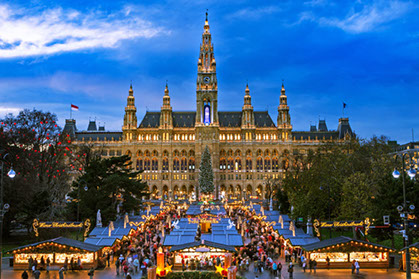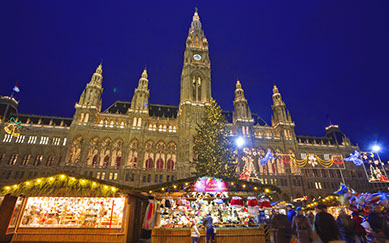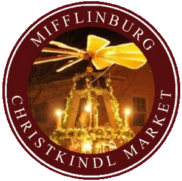FEATURED CITY 2018
Vienna, Austria
Vienna, Austria - 2018
Austria’s City of Music and Christmas Markets
Vienna, or Wien as it is known in German, is the capital of Austria. It is the cultural, political and economic center of Austria and the second largest German-speaking city in the world. Located on the Danube River, the city has its origins in early Roman settlements. In the 11th Century, Vienna became the home of the Babenburg Royal Family. After the extinction of Babenburg rule in the 13th century, the Habsburg Dynasty rose to power and established its residence in Vienna.

The Habsburgs became one of the most powerful families of Europe, expanding Austria and the Holy Roman Empire into a vast empire through military campaigns and alliances created by strategically arranged marriages among the royal families of Europe. Vienna was considered the seat of the Holy Roman Empire for much of the period between 1483 and 1806. From 1806 until the end of World War I, Vienna was the capital of the Austro-Hungarian Empire. Following World War I, Vienna became the capital of the Republic of German-Austria and soon after, the First Republic of Austria. This came to an end with Hitler’s Anschluss in 1938 and World War II. Occupied by the Allies after the war, Austria did not regain its independence until 1955, when it again became the Republic of Austria with Vienna as its capital.
Due to its position as an Imperial City, Vienna became a European center of art and music in the late 1700’s and throughout the 1800’s earning it the nickname “City of Music.” The list of composers working in Vienna include Mozart, Haydn, Beethoven, Mahler, Schoenberg, Johann Strauss I and Johann Strauss II. By the end of the 19th Century, Vienna had become the leader of European Modernism, Intellectualism, Music, Art, and Culinary Arts. Sometimes called the “City of Dreams.” Vienna was the birthplace of modern psychoanalysis through the work of Sigmund Freud.
Vienna is famous for its popular cafés or coffeehouses. Typical Viennese cuisine includes Wiener Schnitzel (breaded veal cutlet), Apfelstrudel (apple strudel) and Tafelspitz (boiled beef) accompanied by Apfelkren (a horseradish sauce mixed with cream and apple) or Schnittlauchsauce (a sauce of chives, mayonnaise and stale bread). Favorite Viennese desserts included Sachertorte (chocolate cake infused with apricot jam) and Vanillekipferl (crescent-shaped cookies popular at Christmas).

Landmarks include the Hofburg, the Belvedere and the Schoenbrunn, the beautiful palaces of the Habsburgs. The Ringstrasse, a wide, landscaped chain of boulevards that rings the Old City, is lined with impressive town homes and apartments, the Rathaus (Town Hall), the Parliament, the Vienna State Opera, and museums. St. Stephen’s Cathedral, with its decorative, tiled roof is situated in the center of the city.
Vienna is home to the famed Lipizzaner Stallions of the Spanish Riding School and the renowned Vienna Boys Choir, both having roots in the patronage of the Habsburgs. Numerous universities and over 100 museums are located in Vienna.
Vienna loves its Christmas Markets. The city hosts over a dozen Christmas Markets simultaneously at various locations throughout the city!
Vienna is the boyhood home of Rudi Skucek, the founder of our Mifflinburg Christkindl Market. As a tribute to Rudi on this, the 30th Anniversary of our own Christkindl Market, we have selected Vienna, the City of Music, as the theme of our 2018 Mifflinburg Christkindl Market.
A presentation on Vienna, featuring photos and short videos, will be given by Matthew Wagner and Brett Hosterman on Thursday at 5:30 PM, Friday 3 PM, and Saturday 3 PM in the Lutheran Church Sunday School room.

